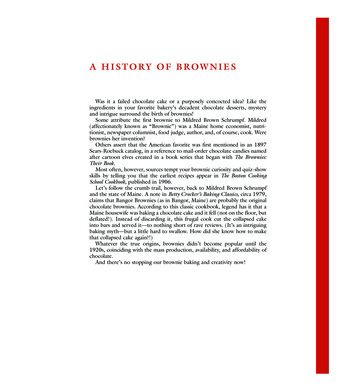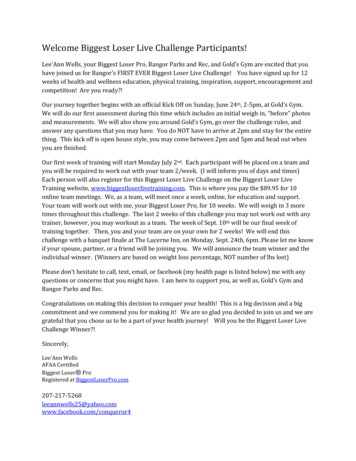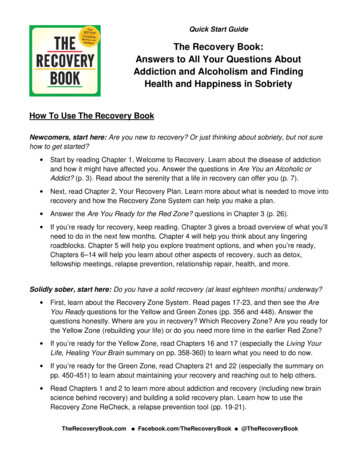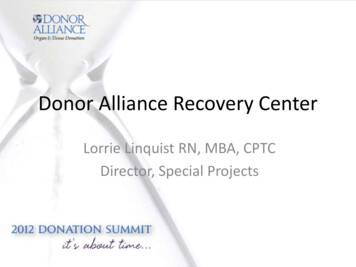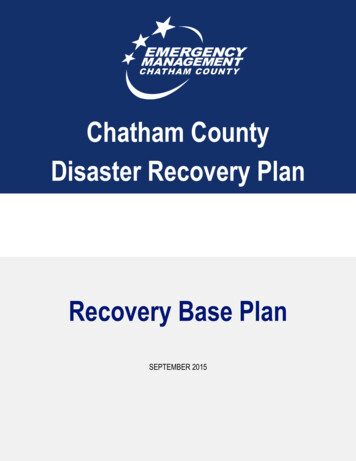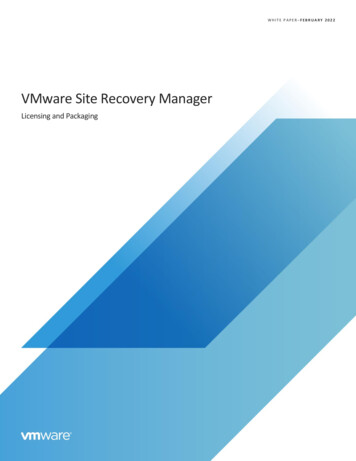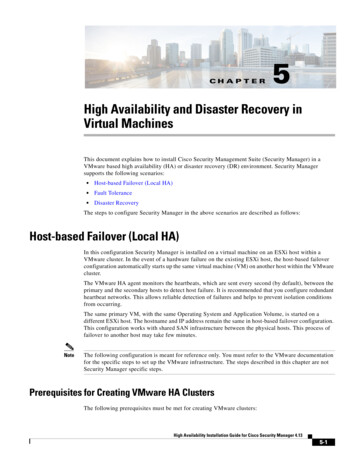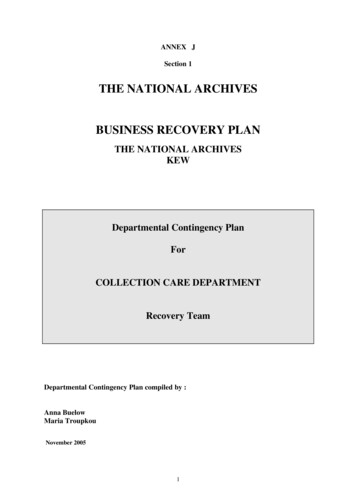
Transcription
Bangor UniversityPROFESSIONAL DOCTORATESRecovery Outside of the Box: Examining Adventure Therapy for Mental HealthRadford, SholtoAward date:2020Awarding institution:Bangor UniversityLink to publicationGeneral rightsCopyright and moral rights for the publications made accessible in the public portal are retained by the authors and/or other copyright ownersand it is a condition of accessing publications that users recognise and abide by the legal requirements associated with these rights. Users may download and print one copy of any publication from the public portal for the purpose of private study or research. You may not further distribute the material or use it for any profit-making activity or commercial gain You may freely distribute the URL identifying the publication in the public portal ?Take down policyIf you believe that this document breaches copyright please contact us providing details, and we will remove access to the work immediatelyand investigate your claim.Download date: 10. Aug. 2022
Bangor UniversityPROFESSIONAL DOCTORATESRecovery Outside of the Box: Examining Adventure Therapy for Mental HealthRadford, SholtoAward date:2020Awarding institution:Bangor UniversityLink to publicationGeneral rightsCopyright and moral rights for the publications made accessible in the public portal are retained by the authors and/or other copyright ownersand it is a condition of accessing publications that users recognise and abide by the legal requirements associated with these rights. Users may download and print one copy of any publication from the public portal for the purpose of private study or research. You may not further distribute the material or use it for any profit-making activity or commercial gain You may freely distribute the URL identifying the publication in the public portal ?Take down policyIf you believe that this document breaches copyright please contact us providing details, and we will remove access to the work immediatelyand investigate your claim.Download date: 06. Jul. 2020
Recovery Outside of the Box:Examining Adventure Therapy for Mental HealthSholto Robert RadfordNorth Wales Clinical Psychology ProgrammeSubmitted in partial fulfilment for the degree ofDoctorate in Clinical PsychologyMay 2020
Table of ContentsAcknowledgments. iDeclaration . iiThesis abstract . 1Chapter 1 – Literature Review . 3Abstract . 5Introduction . 7Methods . 10Results . 18Discussion. 31References . 38Chapter 2 – Empirical Paper. 42Abstract . 44Introduction . 45Methods . 47Results . 52Discussion. 66References . 73Chapter 3 – Discussion Paper. 79Contribution to theory and practice . 80Implications for theory and research. 80Implications for clinical practice . 88Personal reflections . 90References . 98Appendices. 101Word Counts . 123i
Thesis abstractThe environments and contexts in which individuals are embedded have a clear role intriggering and maintaining mental health difficulties. Adventure and wilderness therapiesprovide a radically different environment and way of experiencing oneself. Such a contextmay facilitate change and support recovery and growth. This thesis examines the applicationof such therapies for individuals with mental health difficulties.The first chapter reviews the evidence regarding sustained outcomes of adventure therapy forindividuals with mental health and emotional disorders. Thirteen studies met the inclusioncriteria, ten examining adolescents with mixed presentations and three focussing on adultswith specific mental health conditions. There was evidence of significant follow-up outcomes(3-18 months) across the majority of clinical, behavioural, self-concept and quality of lifemeasures. The promising findings, but generally ‘weak’ quality of these studies, call forfurther exploration of such approaches and more robust research designs.The second chapter employed ethnography to examine sail-training as an adjunctiveintervention for individuals open to Early Intervention for Psychosis Services (EIPS). Thevoyages presented a radical contextual shift characterised by purpose, structure and routine,an intensive and inescapable social environment, the introduction of challenge and adversityand a novel and changing ocean environment. This context supported several positiveprocesses including active engagement and, through this, the development of skills, findingof roles, growing confidence, social-connection, resilience, and a shift in outlookcharacterised by aspiration for change. Individuals also experienced challenges, strugglesand, at times, resistance. The approach has positive implications for social and functional1
recovery, and these are discussed in relation to its unique features. Areas for future researchare also explored.The final chapter discusses the broader implications of this research and introduces a processmodel developed during the empirical research. It concludes with the researcher’s personalreflections on the research process.2
Chapter 1 – Literature Review3
Do adventure therapies have sustained effects for individuals withmental health conditions? A systematic review of the evidenceSholto Radford1, Dr Mike Jackson1 and Dr Marta Eichsteller21. North Wales Clinical Psychology Programme, School of Psychology, BangorUniversity UK2. School of Sociology, University College Dublin, IrelandCorresponding Author: Sholto Radford, North Wales Clinical Psychology Programme, Schoolof Psychology, Bangor University, UK. Email: sepa86@bangor.ac.ukThis paper will be submitted to Psychology and Psychotherapy: Theory, Research andPracticeAuthor guidelines can be found at the following l/20448341/homepage/forauthors.html4
AbstractObjectives: Adventure therapies may offer an alternative or supplementary treatment forindividuals with mental health conditions, particularly those who may not engage with moreroutinely offered interventions. This systematic review aimed to establish if there wasevidence of sustained outcomes of such therapies in clinical populations. Methods: Threedatabases were systematically searched, and criteria defined for studies to be furtherconsidered for inclusion. A quality assessment was then conducted and effect sizes fromfollow-ups estimated. Results: Thirteen of 1,045 studies were selected. Most involved youthand adolescents with mixed mental health and emotion disorders (10), with three studiesexamining adults with specific mental health conditions. Reported interventions varied inlength and therapeutic approach, although 8 were American studies on Outdoor BehaviouralHealthcare. Most studies rated weak (10), commonly resulting from a lack of blinding,confounders, and high withdrawal/ dropout rates. This, as well as heterogeneity ofinterventions and sample characteristics, precluded the meaningful calculation of overalleffect sizes. There was nonetheless evidence of statistically significant positive follow-upoutcomes across studies, on the majority of clinical, self-concept and behavioural constructs.Conclusions: There was a promising indication that outcomes from adventure therapy inmental health populations could be maintained over time. As the quantity and quality ofevidence remains weak, further development and research in this area should be given seriousconsideration in light of the large effect sizes reported and the paucity of applications of suchapproaches in a UK context.5
Practitioner PointsClinical implications This review provides the first systematic synthesis of evidence of sustainedadventure therapy outcomes for individuals with mental health and emotionaldisorders. There is evidence of significant clinical, behavioural and self-concept outcomesbeing maintained at follow-ups of three to eighteen months.Limitations The evidence included in the review is of limited quality Adventure therapy may face key difficulties in establishing a gold standardevidence base due to inherent difficulties including randomisation, and blinding.Key words: adventure therapy, wilderness therapy, mental health, long-term outcomes,systematic review6
IntroductionMental health services in the United Kingdom have a remit to deliver psychologicaltherapies. However, attrition rates for current evidence-based approaches such as CognitiveBehavioural Therapy (CBT) are high, averaging 40% (Fernandez et al., 2015). Activeoutdoor therapies, which draw on experiential learning, have been used as an alternative andadjunct to routine treatment options (Bowen & Neill, 2013), often with client groups who areless responsive to the latter (Lariviere et al., 2012). Nevertheless, they are not routinelyavailable in most UK services.Adventure therapy has been used as an umbrella term to describe a variety of relatedapproaches including wilderness therapy, adventure-based counselling, outdoor behaviouralhealthcare, and therapeutic camping, to name a few (Itin & Mitten, 2009). Despite attempts tounify the field, there is a wide diversity in approaches, conceptualisations, and definitions ofoutdoor and adventure-based therapies (Russell, 2001a; Crisp, 1998). A widely useddefinition, however, is “the use of traditional therapeutic techniques especially for grouptherapy in out-of-doors settings, utilizing outdoor adventure pursuits and other activities toenhance personal growth” (Davis-Berman & Berman, 1994). Russell (2001) proposes atheoretical basis with common wilderness and adventure concepts derived from outwardbound programmes, but with an integrated therapeutic model drawing on family systemsperspectives and cognitive behavioural approaches. The contextual shift, away from the homeenvironment, which is implicated in the maintenance of difficulties, has been highlighted as akey to this therapeutic modality (Newes & Barndoroff, 2004; Russell, 2001).The majority of adventure therapy programs to date serve adolescents often with mixed,comorbid mental health conditions, substance use, mood, anxiety and/or behaviouraldifficulties (Bettmann and Tucker, 2011; Russell, 2003). They have also been applied in adultpopulations (Voruganti et al., 2006) and youth justice (Wilson & Lipsey, 2000; Bedard,7
Rosen, & Vacha-Haase, 2003). In the UK, there is emerging interest such as the developmentof an adjunctive adventure therapy programme through the National Early Intervention forPsychosis (EIPS) steering group in Wales.Evaluating the efficacy and effectiveness of such interventions within clinical populations isan important stage in their wider implementation across UK mental health services. It is alsoimportant to understand whether such interventions, characterised by individuals being takenout of routine daily environments and exposed to novel outdoor environments and socialgroup dynamics (Russell & Farnum, 2004; Fernee, Gabrielsen, Andersen, & Mesel, 2017),are context-dependent or can have lasting effects.To date, of the reviews that have been conducted on the effectiveness of adventure andwilderness therapies, none have specifically reported on follow-up effects in clinicalpopulations. The review by Hattie et al. (1997) found evidence of substantial follow-upeffects (Cohen’s d 0.51), for outcomes such as locus of control, self-concept and leadership,but had an educational rather than therapeutic focus and did not represent clinicalpopulations. Bettmann et al. (2016) reviewed wilderness therapy programmes which treatedclinical populations exclusively, but, due to a lack of consistency in follow-up data, onlyreported pre-post intervention effect sizes. Bowen and Neil (2013) conducted the mostcomprehensive and widely cited meta-analysis to date, including 197 studies, although themajority (119) were unpublished sources. They reported moderate short-term effect sizesacross a broad range of outcomes including clinical, self-concept, social development,behaviour, academic , morality/spirituality , family development and physical (Hedges’ granging from 0.17 to 0.50), with mean effect sizes comparing favourably to alternativetreatments (g 0.14) and no treatment (g 0.08) groups. They further reported little follow-upchange (0.03), which suggested maintenance of effects. Their extensive work provides abroad brushstroke of adventure therapy effects, but several limitations jeopardises the8
conclusions that can be drawn regarding sustained effectiveness within clinical presentations.Firstly, the study amalgamated a broad range of population characteristics, with only 30 ofthe 196 studies focussing specifically on mental health; secondly, it failed to report follow-upperiods for the calculated effect sizes; thirdly, a wide variety of outcome measures (30) weregrouped together under the “clinical” category. The heavy reliance on non-peer reviewedstudies further raises questions regarding data quality.Hence, there is evidence, albeit scarce, that positive outcomes from immersive outdoortherapies can be maintained (Bowen & Neil 2013) or that those outcomes can continue toimprove (Hattie et al., 1997) over a follow-up period. However, these conclusions cannot begeneralised to provide a strong evidence base to the potential effectiveness within mentalhealth populations. This is because of the heterogeneity of sample characteristics,amalgamation of outcome measures, lack of detail of follow-up length and paucity of peerreviewed published material found in these reviews.The current study aimed specifically at reviewing the evidence for sustained outcomes ofimmersive outdoor therapies, such as wilderness and adventure therapy, for individuals withclinical mental health presentations. Further, by focussing exclusively on studies reportinglonger-term effects, it aimed to report a more in-depth and nuanced picture of clinicalcharacteristics and outcomes than was previously available in the literature. To maximise thereliability of reported findings, it draws exclusively on peer-reviewed studies as well aspresents a quality assessment of included papers.9
MethodsSearch strategyThree databases, ProQuest (APA Psychinfo, PTSDpubs, Social Science Premium Collection),Web of Science core collection and EBSCOhost (Cinahl and Medline), were searched withthe search terms given in Table 1. Those search terms were derived from a preliminaryliterature scoping exercise. Language was restricted to English. Selected articles werepublished in peer-reviewed journals only. No limit on publication date was specified. Theinitial search resulted in 1,030 studies (Figure 1). Reference lists of relevant meta-analyses(Bowen & Neill, 2013; Gillis et al., 2016; Bettmann et al., 2016), as well as key papers withinthe literature, were searched, resulting in 15 additional papers.Table 1. Search termsWilderness Therapy* OR Adventure Therapy OR Wilderness Treatment OR "Therapeutic camping"OR "Therapeutic camps" OR Outdoor adventure programming OR Outdoor therapeutic program*OR Outdoor adventure OR Adventure-based counsel* OR Adventure counsel* OR Therapeuticadventure Outdoors OR Outdoor behavioural health* OR Adventure-based therapy ORAdventure-based experiential therapy AND "Mental Health" OR Psychosis OR outpatient ORPsychiatric OR Psychiatry OR Personality disorder OR Bipolar OR Schizo* OR Post-traumatic ORPTSD OR Serious mental illness OR "Mentally Ill" OR Mental illness OR Depression OR Anxiety ORmood disorder OR eating disorder OR Obsessive-compulsive disorder OR OCD.ScreeningThe resulting 774 non-duplicate papers were screened by the first author based on title andabstract (see selection criteria Table 2). Full-text articles of the 67 remaining papers werethen reviewed with the same criteria, resulting in 13 publications for inclusion in the study. In10
cases where there was ambiguity over inclusion, full-text articles were reviewed by thesecond author. The PRISMA flow diagram displays the screening process (Figure 1).Table 2. Selection CriteriaInclusion Criteria The article describes the target population for the intervention as having mental healthor emotional disorders. The intervention involves an immersive environmental shift defined as at least oneovernight stay outside of their usual environment. The intervention includes an element of adventure or challenge-based activity forpsychological or behavioural purposes. The study includes a minimum of three months post-intervention follow-up.Exclusion criteria Data already published in included main study Studies adopting single-case designs Studies adopting solely qualitative methodologies Non-primary research (e.g. systematic reviews) Where the target population is principally selected based on physical health conditions ordisability, criminal and delinquent behaviours or learning disabilities11
Figure 1. PRISMA flow of systematic review studiesQuality assessmentA quality assessment was conducted on the 13 selected papers using the Quality AssessmentTool for Quantitative Studies (QATQS) (Appendix 1), tool chosen for its quality andsuitability for non-Randomised Clinical Trials (non-RCTs) as recommended by Deeks et al.12
(2003). The global quality rating on the QATQS assesses study quality and sources of bias inthe following domains: selection bias, study design, confounders, blinding, data collectionmethods, and withdrawals and drop-outs, each rated weak, moderate or strong. A globalrating of strong (no weak ratings), moderate (one weak rating) or weak (two or more weakratings) is computed from the six domains. All included studies were rated by the first andsecond authors and, in line with QATQS guidance, any discrepancies discussed.Data extraction and synthesisData were systematically extracted from studies and displayed in tables. There was variationin reporting of data and analyses within the studies which had a bearing on presentation oflong-term outcome results. Single cohort designs tended to present pre- to post- interventioneffects and then post- to follow-up effects, whereas controlled designs conducted an analysisof variance with time point (including follow-up) and intervention condition as independentvariables. Statistics of significant effects were included in the results as reported in thestudies (including significance thresholds assumed, e.g. Gabrielsen et al., (2019) uses a pvalue of 0.1 to assert significance). Some studies presented the effect size value, Cohen’s d(Cohen, 1988), of within-group pre-intervention to follow-up change, with its associated pvalue. For comparability, Cohen’s d estimates were re-calculated here for all studies.Due to heterogeneity across study interventions, and participant characteristics, as well asweaknesses in studies quality, the calculation of overall effect sizes through meta-analysiswould potentially be misleading and was therefore not performed.13
14
Table 3. List of peer-reviewed publications included in the review with description of design, samples, intervention and quality ratings.AuthorsSampleCountryBowen, Neill, & Crisp(2016)AustraliaDemographics (and sample size n)Intervention:- Age range: 12-1; mean 14.6- Gender: Female 58%- n 36Control: NAInterventionClinical CharacteristicsOutpatients of an Adolescent Mental Health ServicePresentations:- Conduct/ behaviour (29%)- Depression (21%)- Anxiety (14%)- Identity/ self-esteem (14%)- Relationship problems (14%)- Psychosis (8%)Post discharge samplePresentations DSM-IV:- Mood disorders (75%)- Substance-use disorders (63%)- Anxiety disorders (58%)- Behavioural disorders (59 %)- Attachment disorders (5%)- Pervasive developmental disorders PDD (1%)- Learning disorders (5%)Combs, Hoag, Roberts,& Javorski (2016)USAIntervention:- Age range not reported; mean 16.2- Gender: Female 32% (of adolescents)- n 659 (parents of adolescents)Control: NADeMille et al. (2018)USAIntervention:- Age range 12-17; mean 15.7- Gender: Female 33%- n 60Control: TAU- Age range 12-7; mean 14.98- Gender: Female 36%- n 60Referred for emotional behavioural and substanceuse disorders and been unsuccessful with lessrestrictive treatment modalitiesIntervention:- Age range not reported; mean 36- Gender: Female 56%- n 16Control: comparison group- Age range not reported; mean 37- Gender: Female 68%- n 37Applicants to psychiatric hospital with diagnosis ofavoidant personality disorder according to DSM-IVEikenaes, Gude, &Hoffart (2006)NorwayControl:Matched sample of 60 parents who inquired intoOBHC but sought alternative intervention withstratification based on ethnicity age and YOQ scoresControl:Patients previously treated in psychiatric hospitalbetween 1992 and 199415Design / Follow-up (Lengthand sample size n)Global Qualityrating (QATQS)Wilderness Adventure Therapy (WAT)10-week manualised intervention:- 7 individual days- 2 day overnight training- 5 day expeditionTherapy: Multi systemic group therapyNo controlFollow-up: 3 months; n 36WeakOutdoor Behavioural Health Care(OBHC)10.4 weeks in field (mean length):- Expedition (hiking) in wilderness- Experiential skills (e.g. fire making,shelter building)Therapy: Cognitive Behavioural therapy,Choice therapy, Family systems,MindfulnessNo controlFollow-up:random selection of N 200- 6 months; n 99- 18 months; n 106WeakOutdoor Behavioural Health Care(OBHC)Wilderness expedition mean 80.5 daysTherapy: Integrated model givingintervention for mental healthsubstance use and health; Mentalhealth providers two days a week infield; Individual and grouppsychotherapy; Weekly family therapyNon-equivalent control groupFollow-up: 12 months;intervention n 60control n 60(Only included completed datasets27.9% of those whoagreed to participate in TAU)WeakIntegrated Wilderness Therapy (IWT)6-day wilderness trip in non-civilizedarea3-day canoeing tripTherapy: Daily group therapy sessionsin supplement to treatment in hospital(group sessions psychodynamicapproaches art therapy)Non-equivalent control groupFollow-up: 12 months; n 16Moderate
AuthorsSampleCountryInterventionDemographics (and sample size n)Intervention:- Age range 16-18; mean 16.5- Gender: Female 66%- n 32Control: NAClinical CharacteristicsParticipants were admitted to the specialized mentalhealth care system due to the severity of theirmental health (social anxiety depression behaviourdisturbance, adjustment disorders and mentalfatigue)Harper, Russell,Cooley, & Cupples(2007)USAIntervention:- Age range 13-18; mean 15.5- Gender: Female 38 %- n 252Control: NALewis (2013)USAMcLendon,McLendon, Petr, Kapp,& Mooradian (2009)USAGabrielsen et al.(2019)NorwayRoberts, Stroud, Hoag,& Massey (2017)USADesign / Follow-up (Lengthand sample size n)Global Qualityrating (QATQS)Friluftsterapi (Wilderness Therapy)8-10 week duration:- 8 single days- 2 overnight trips (each 3-6 days)Therapy: Ongoing group and individualtherapyNo controlFollow-up: 12 months; n 19WeakEmotional and behavioural or substance usediagnosisWilderness Therapy Program21 days expedition backpacking andraftingTherapy: Individual and group therapy;Systemic approach with familyparticipation in pre and post tripprocesses.No controlFollow-up:- 2 months; n 124- 12 Months; n not specifiedWeakIntervention:- Age range 13-17; mean 15.69- Gender: Female 34 %- n 190Control: NAAdolescent’s parents sought admission for mentalhealth and substance related treatmentOutdoor Behavioural Health Care(OBHC)57.48 days in field (mean)Therapy: Individualised treatmentplans; Weekly group and individualtherapy; Psycho-educational trainingNo controlFollow-up:- 3 months; n 138- 12 months; n 120WeakIntervention:- Age ranges 6-17 and 27-64; mean 12.1and 40.9- Gender not reported- n 52 children and 41 adults (93 total)Control: comparison group- Age ranges 8-20 and 30-55; mean 12.9and 41.3- Gender not reported- n 31 children and 26 adults (57 total)Intervention:- Age range 18-32; mean 20.3- Gender: Female 17.7 %- n 186Control: NAReferred from Community Mental Health CentreservicesCriteria:- Need for family therapy to address behaviourproblems of a Seriously Emotionally Disturbed (SED)child or a problematic adult relationship- SED had a diagnosable mental disorderTherapeutic wilderness family camp3 days wilderness camps (3-5 families)adjunct to CMHC engagementTherapy: Adults attendee three x 3 hourFamily directed Structural Therapy(FDST) groups with concurrent childgroups, one of these family groupsincluded an adventure based activityNon-equivalent control groupFollow-up: 6 months; n 30ModeratePrimary diagnosis leading to seeking of treatmentPresentations:- Mood disorders (38.7%)- Substance use disorders 30.6%- Anxiety disorders 13.4%- Pervasive development- Behaviour and attachment disorders 17.2%Outdoor Behavioural Health Care(OBHC)5-25 weeks in wildernessTherapy: Weekly individual and grouptherapyNo controlFollow-up:- 6 months; n 81- 18 months; n 79Weak16
AuthorsSampleCountryRussell (2003)USARussell (2007)USATaylor et al. (2017)AustraliaVoruganti et al. (2006)CanadaInterventionDemographics (and sample size n)Intervention:- Age range not reported; mean notreported; 75% of participants of age 16-18- Gender: Female 31%- n 858Control: NAClinical CharacteristicsDiagnosed with Variety of Disorders (DSM-IV)including:- Oppositional defiant disorder (29%)- Substance disorders (26%)- Depressive disorders (15%)Intervention:- Age range not reported; mean 15.9;67% of participants of age 16-17- Gender: Female 32%- n 774Control: NAIntervention:- Age range 26-63; mean 44.5- Gender: Female 67.8%- n 28Control: TAU- Age range 21-84; mean 48.87- Gender: Female 52.2%- n 23Intervention:- Age range not specified; mean 32.04(SD 7.51)- Gender: Female 17.3%- n 23Control: TAU- Age range not specified; mean 40.83(SD 9.44)- Gender: Female 25.8%- n 31Diagnosis of schizophrenia or schizoaffectivedisorder but clinical stability of 6 months or longerDesign / Follow-up (Lengthand sample size n)Global Qualityrating (QATQS)Outdoor Behavioural Health Care(OBHC)Programs differed in length 3 weeks to180 days (only 21 days in wilderness) Average 45 daysTherapy: Clinical supervisor andmasters level counsellors visiting groupsin field (3-6 day intervals)No ControlFollow-up: 12 months;Random sample of Parent n 144Clients n 99Weak 90% diagnosed DSM-IVMental health, substance use disorders andcombined mental health and substance useOutdoor Behavioural Health Care(OBHC)Median 49 days in wildernessOther details not specifiedNo controlFollow-up: 6 months;n 260 parents and youthrandomly selectedWeakDiagnosis of severe mental illnessDepression, bipolar, schizophrenia andschizoaffective disorderTherapeutic Recreation5 day camp - Variety of bothadventurous / recreation as well asmore mindful activities: high ropes, rockclimbing, giant swing, flying fox daily taichi evening bush dance art and craftand problem solving and team
an intensive and inescapable social environment, the introduction of challenge and adversity . Sholto Radford1, Dr Mike Jackson1 and Dr Marta Eichsteller2 1. North Wales Clinical Psychology Programme, School of Psychology, Bangor . (0.03), which suggested maintenance of effects. Their extensive work provides a broad brushstroke of adventure .


